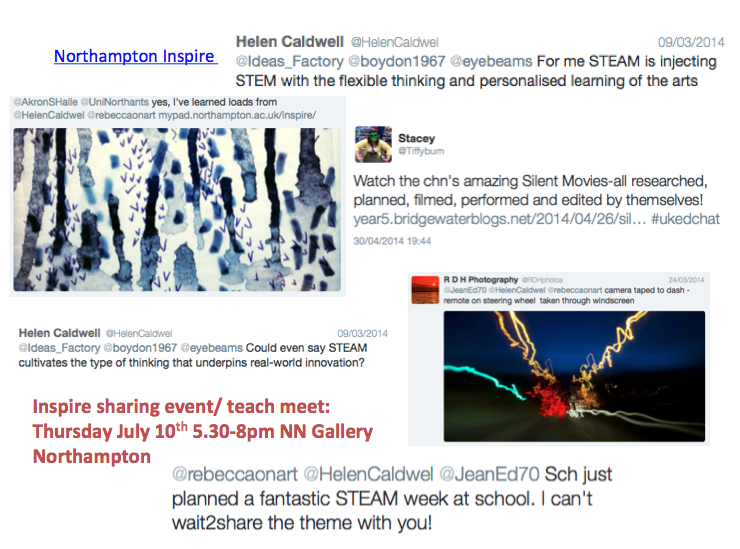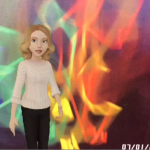The Northampton Teaching and Learning Conference 2014
From Stem to SteAm: Integrating Technology and the Arts in the Creative Classroom
Why?
“The future of innovative thinking in STEM disciplines relies on breaking down the distinction between disciplines traditionally seen as “creative” like the arts or music and STEM disciplines traditionally seen as more rigid or logical-mathematical. (Henriksan 2014 cited Catterall, 2002)
We identified a need to be responsive to current developments in education and contemporary life in relation to developments in the new National Curriculum and our advancing technological culture.
-Arts in education being minimised
-Extensive changes in the computing curriculum to include a holistic approach and an emphasis on techniques
Key project aims included:
- Enabling children, teachers and students to be at the forefront of their global culture, allowing them to be ‘change makers!’
- Building a community of practice to widen participation in the field of SteAm and developing innovative and exemplary models of practice integrating the arts and technology.
- Exploring how the concept of ‘multi-sensory culture’ could be embedded within the art and computing curriculum and across education systems.
“It’s not about adding to the acronym, but instead adding to the relevancy of learning. It’s about showing students how technical concepts relate to real-world situations and providing them with hands-on projects and problems that help them apply concepts in a new context. It’s about nurturing students’ curiosity and helping them develop creativity, problem solving and critical thinking skills.” (Vince Bertram,2014)
Generating a network- in response to the problem
– The generation of a university based and online CPD network uniting practitioners, industry, university teacher researchers and technologists.
– Explore our meetings page and CPD to find out more.
– Projects have rippled in to our local schools and a team of ‘Digital Leaders‘ has been created to support teachers with the development of this practice.
Active online networks are moving thinking forward and reaching a larger audience informing national debate.
Join us on Twitter @rebeccaonart and @HelenCaldwel
Research outcomes to date: Best explored through a case study…
- We are more informed about what an interdisciplinary approach to education can add to learning and teaching for both staff, students and pupils.
- A significant increase in the integration of arts and technology practice in our local schools has been noticed.
- All research participants appear to be trialling new teaching approaches in response to their knowledge of global and multi-sensory culture. Therefore participating in becoming change makers in their field.
- A series of videos have been created to be shared on a web TV channel and practice is being shared internationally via our blog and social media.
- Joined up thinking is also occurring across the University between The School of Education and The School of the Arts.
Exciting outcomes surrounding light trails by year 5 pupils at Bridgewater Primary School.
Where next:
Our dream: Through the use of social media, school and university links we hope to internationalise the project and identify how global culture within the arts and technology in interdisciplinary fields can inform educational development.
– To further involve industry in the integration of our approach starting with our teach meet and Inspire project event at the NN gallery on the 10th June 2014.
-To continue to analyse the data gathered and write specialist papers within the field of arts and ICT education about how the concept of SteAm is developing as a result of network generation, addressing both advantages and limitations to learning.
A workshop surrounding the project is to be presented by Rebecca Heaton and Helen Caldwell at the International Conference of ICT in Education this July.
Key References:
-
Burnard, P., and Hennessy, S. (Eds.). (2006). Reflective practices in arts education (Vol. 5). Dordrecht: Springer.
-
Freedman, K., and Stuhr, P. (2004). Curriculum change for the 21st century: Visual culture in art education. Handbook of research and policy in art education, pp815-828.
- Henricksen, D. (2014). Full STEAM ahead: Creativity in excellent STEM teaching practices. [Online] Available from: http://scholarship.claremont.edu/cgi/viewcontent.cgi?article=1038&context=steam [Accessed 20.5.14]
-
Platz, J. (2007). How do you turn STEM into STEAM? Add the Arts! [Online]. Available from: http://www.ikzadvisors.com/wp-content/uploads/2009/09/STEM-+-ARTS-STEAM.pdf [Accessed 13.02.14].
- Robelen, E. W. (2011). STEAM: Experts make case for adding arts to STEM. [Online]. Available from:http://www.edweek.org/ew/articles/2011/12/01/13steam_ep.h31.html [Accessed 13.02.14].





